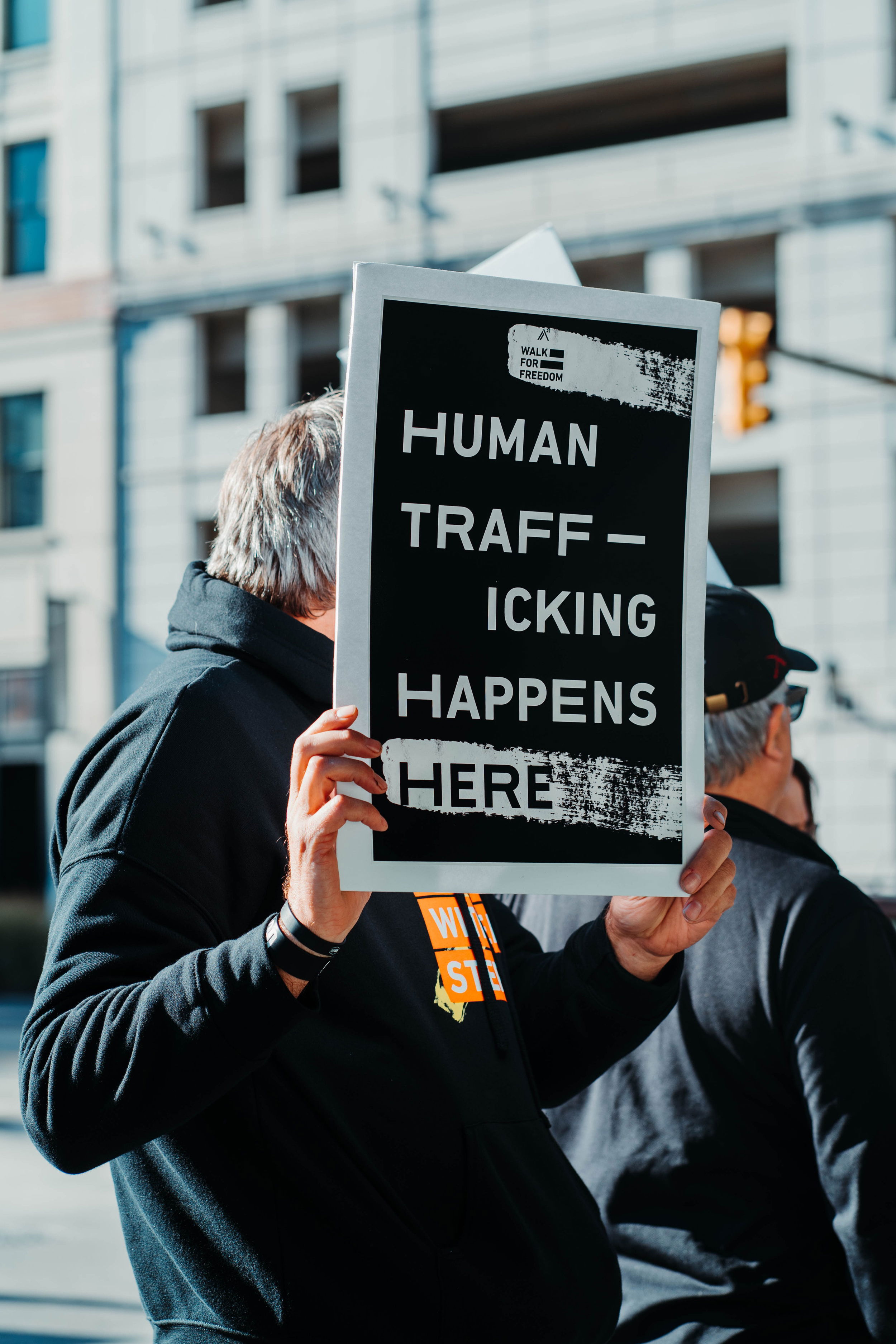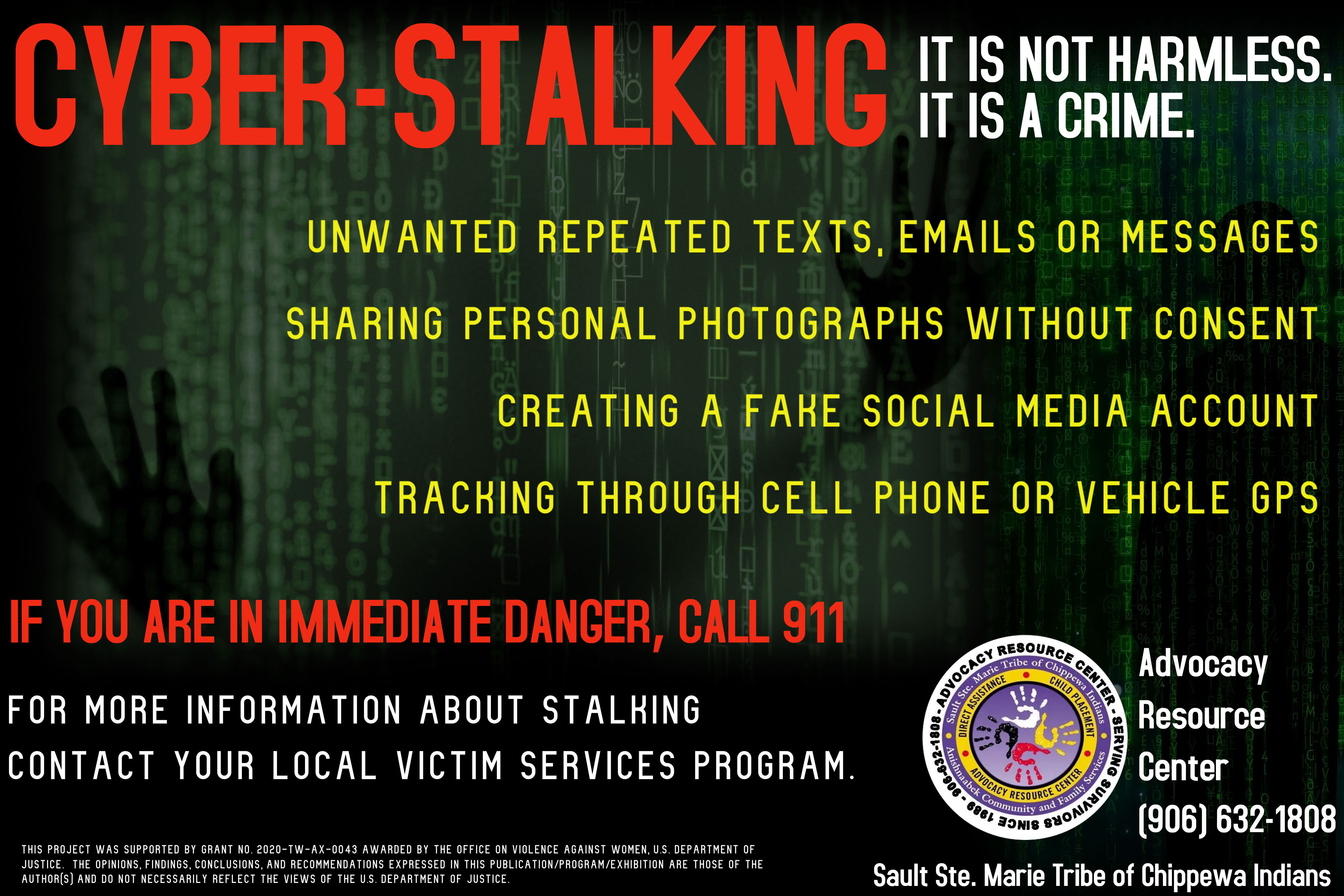January is Human Trafficking and Stalking Awareness Month
Human Trafficking is defined as defined as “the action or practice of illegally transporting people from one country or area to another, typically for the purposes of forced labor or commercial sexual exploitation”. Human trafficking is the trade of people, notably women and children, and does not necessarily involve the movement of the person from one place to another. It is also referred to as “modern day slavery”.
RED FLAGS OF POWER AND CONTROL:
Red Flags – Indicators of Human Trafficking Red Flags
Indicators of Abuse and Control You learn or suspect that the potentially trafficked person:
• Must work against their will
• Cannot leave their current situation
• Has been threatened with:
• Violence, against their loved ones
• Arrest or deportation
• Even worse working conditions
• No pay for work provided
• Is punished physically when they do something wrong
• Can only leave home to go to work, or that activities outside of work are highly controlled
• Sleeps where they work, or has no private space
• Has moved from place to place often
• Is unfamiliar or unaware of their surrounding environment
• Has limited or no control over their working conditions
• Works excessively long hours with few breaks or days off
• Has no money or access to money, or hands over their money to someone else
• Is bonded by debt to another person.
• Does not have access to medical care.
• Has limited contact with friends or relatives.

The person shows other signs that they are being abused or controlled.
For example, the person:
• Is fearful or anxious in general, or is afraid of the police or other authority specifically
• Is always accompanied by someone else
• Allows that other person to speak for them, even when directly addressed
• Acts as if they are following instructions, or talks as if they are reading from a script
• Cannot make an appointment on their own (without control over their own schedule)
• Has visible scars or injuries, such as bruises around their wrists from being tied up, or cigarette burns on the inside of their arms or legs
• Is hungry or appears malnourished
Red Flags: Indicators of Trafficking for Sexual Exploitation
You find out the person is suffering from:
• A sexually transmitted infection or disease
• Pelvic, rectal or urinary trauma (evidence of unprotected or violent sex and multiple or
forced abortions)
• Mental health issues, including depression
• Post-traumatic stress disorder
• Memory loss
• Drug and/or alcohol addiction
• Malnutrition
• Other health issues, such as back, hearing, cardiovascular or respiratory problems
You notice that the person:
• Has scars or injuries or other signs of abuse or torture
• Uses a cell phone to call the same person at regular intervals
• Has a tattoo of a gang symbol or a name on their neck or elsewhere that suggests ownership, or wears gang colors or jewelry (such as a necklace in the shape of a gang symbol)
https://www.kristenfrenchcacn.org/

Red Flags: Indicators of Trafficking for Forced Labor
You learn or suspect that the person:
• Lives in the same place that they work, possibly with a number of others
• Lives in an unsuitable place, of sub-standard quality such as a basement, old barn or storage shed
• Works for very long hours — more than eight hours a day or more than five days a week
• Works in unhealthy or unsafe conditions
• Does not have a contract for the work they are doing, or was forced to sign an illegal
contract
• Cannot leave their current job, but won’t say why
• Receives no pay or receives less than minimum wage for their work
• or is required to pay a portion of their wages to someone else
• Receives no benefits from their work, such as sick leave or overtime
• Has fines taken off their pay if they do something wrong
• Must pay for tools, food, accommodation and/or transportation out of their wages
You may also notice that the person:
• Does not have the right clothing or protective gear for their job, for example steel-toed
boots and a helmet for someone who works on a construction site
• Is qualified for a particular job, but is working in a different one — for example, a qualified
plumber is working to clear brush in the forest
If you go to a job site, you may see:
• The absence of health and safety notices on the walls
• The absence of health and safety equipment
Information provided directly from https://www.kristenfrenchcacn.org/
Red Flags: Indicators of Trafficking for Domestic Servitude
You learn or suspect that the person:
• Does not eat with the family, or eats only leftovers
• Appears malnourished or tells you that they are hungry
• Is unable to leave the home, or may only leave in the company of a member of the
household
• If they are able to leave the house, their movements and activities are restricted
• Is expected to be available to work up to 24 hours a day, with few or no days off
• Does not know much about the community around them (due to being isolated)
• Has been physically or sexually assaulted by their employer or members of the household

Red Flags: Indicators of Child Trafficking
You learn or suspect that the minor:
• Does not have or cannot reach a parent or guardian.
• Is not going to school or is working during school hours.
• Lives with someone unrelated to them and not a guardian.
• Does not have any friends their own age outside of work.
• Has no time for playing.
• Is engaged in work that is not suitable for children, such as heavy lifting or working with dangerous chemicals.
• Travels unaccompanied, or in groups who are not relatives.
• Has someone in their life (not a parent or guardian) who arranges where they live and how they travel, or who buys them everything they need.

In cases of child trafficking for sexual exploitation, you may notice that the child or youth:
• Dresses more provocatively than a typical minor
• Has more cash, more expensive clothes or gadgets that were received as “gifts” from an unknown source
• Has fake identification that states they are older than they really are
• Has a hotel room key or other items that a typical minor would not have

Red Flags: Indicators of Child Recruitment for Sexual Exploitation
You notice that the child or teenager has started to:
• Dress more provocatively
• Stay out later or all night
• Hang out with new friends who are older than them
• Ignore childhood friends and family members
• Drink or use drugs
• Skip school
• Skip meals
• Skip showers or stop changing clothes
• Ignore rules and instructions at school or at home
• Lie
• Wear new clothes, shoes or jewelry of unknown origin
• Spend more money and buy more things such as iPods or video games
• Receive gifts from a new friend or boyfriend
• Talk about a modeling or other job contract waiting in another town or city
• Become more secretive about spending time online
• Become frightened of being online
• Does not speak English or French or experiences language barriers

Red Flags: Indicators of International Trafficking
The person:
•Travelled internationally for a specific job, but may not have that job now
•Travelled with a valid visa (i.e. student, visitor, temporary worker) but is forced to breach their visa conditions
•Travelled a long and possibly indirect route to get to destination
• Won’t say how they got to destination
• Does not have access to their passport or travel documents
• Is reluctant to tell you their immigration status or show you travel or immigration documents if they have them
• Is worried about their immigration status in
• Does not speak English or French or experiences language barriers
Information provided directly from https://www.kristenfrenchcacn.org/
IF YOU NOTICE ANY OF THESE RED FLAGS AND HAVE CONCERNS THAT SOMEONE IS BEING TRAFFICKED-CONTACT YOUR LOCAL POLICE DEPARTMENT. IF YOU NOTICE A RED FLAG AT YOUR PLACE OF EMPLOYMENT (CASINO, HOTEL, BUS STATION, ETC.) ADDRESS YOUR CHAIN OF COMMAND. DO NOT ATTEMPT TO TAKE MATTERS IN YOUR OWN HANDS. BY PERSONALLY INTERFERING YOU MAKE THE SITUATION WORSE FOR THE VICTIM. GATHER AS MANY DETAILS AS POSSIBLE AND REPORT IMMEDIATELY.
STALKING
Stalking is defined as “a pattern of behavior directed at a specific person who would cause a reasonable person to feel fear”. There are a many different methods or tactics that stalkers use to pursue their victims. Stalking can include but is not limited to, having unwanted or unsolicited phone calls, texts, emails, social media contacts, unwanted gifts, and showing up or approaching an individual or their family or friends. Stalking also can include monitoring, surveillance, property damage, and threats to the victim or their family. Cyber-stalking committed by using a device to monitor or surveille a victim without their knowledge and is now a punishable crime.
Stalking is dangerous and can result in serious injury or death to a victim.

Most stalking victims are stalked by someone they know.
Most often, people are stalked by someone they already know. That could include a current or former intimate partner or spouse, an acquaintance, coworker, or family member. It could also be a stranger who has been watching from afar.
Native women are stalked at more than twice the rate of other women. According to information provided by the Coalition to Stop Violence Against Native Women and information from the 2016 National Institute of Justice Research Report: Violence Against American Indian/Alaska Native Women and Men 48.8% of American Indian/Alaska Native women have experienced stalking in their lifetime.
Stalking is now a crime in all 50 states but requires ample proof/documentation of incidents/encounters to help solidify a prosecution in the case.
Maintaining a detailed “stalking log” is best to keep to record and documenting all stalking-related behaviors. These behaviors include harassing or repetitive phone calls or text messages, emails, social media contacts, acts of vandalism, and threats. Keeping an accurate and detailed log with dates, times, locations, and even photos of the stalker in the act can be helpful to prosecute the stalker.
Download a stalking log here from SPARC:
For more information from SPARC (Stalking Awareness Prevention Resource Center): https://www.stalkingawareness.org/
Cyber-stalking is now a punishable crime.

If you want to share your story or comment on the information, please feel free to use the comment section or message the inbox privately for advocacy or support.